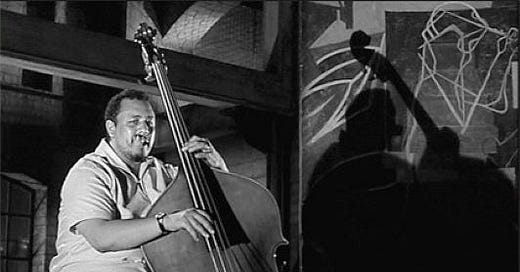The Shadows of Charles Mingus
In the 1930s and '40s the film industry was almost totally controlled by the major studios. These companies (predominantly MGM and Paramount) controlled not only production and distribution, but also almost every first run movie theater in the country. When this vertical monopoly was ended in 1948 by the Supreme Court upholding what was known as the “Paramount Consent Decree”, the studios were forced to sell off their theaters.
This made movie screens across the country available for films made outside of the Hollywood system and by the 1950s, the idea of pictures made by individual producers, actors, or directors without studio backing or supervision began to take hold. This new, more idiosyncratic and personal type of film making would mirror the influence of the great wave of post war international films coming from Europe and Japan.
One of the first of the American “Independents” was actor/director John Cassavetes, who in the mid-1950s conceived of making his own improvisational films. His first picture was “Shadows”, an examination of interracial love and racial prejudice set in New York's world of musicians, hipsters and the music scene of that time.
Cassavetes initially wanted Miles Davis to score the film, but with an extremely limited budget (the whole film is reported to have cost a miniscule $40,000), Cassavetes simply could not afford him. His second choice was up and coming bassist/composer Charles Mingus.
In keeping with the overall approach of the film, Cassavetes wanted completely improvised music played spontaneously while the musicians were viewing the film for the first time, while Mingus insisted on a formal written score – without having access to the finished film for reference!
When Mingus and his band showed up for the scoring session, Mingus had brought several actual tunes that he and his band attempted to play in time to the film being played back. This idea was not successful and yielded virtually nothing that would work as film music.
With limited time available, studio costs piling up and nothing tangible to show for it, Cassavetes and Mingus started over with what has been termed “an exercise in disaster salvation”, which was in fact the way both artists typically worked. With several Mingus tunes recorded, Cassavetes called for simple improvised percussion pieces and bass solos which could be edited in behind the action on screen.
Overall, the resulting film was admittedly a failure. At the film's premiere screening, audience members and even Cassavetes himself hated it. The director had no choice but to completely revise his picture, re-writing (actually revising the outline the actors improvised from), re-shooting, re-editing and re-scoring the film using a single solo saxophone played by Shafi Hadi during key scenes. This second version of “Shadows” became the first independent film hit, winning the critics award at the Venice Film Festival. (This final version is available on multiple streaming sites as well as on You Tube.)
But what of Charles Mingus' original score, which was almost entirely left out of the second, final, version? After decades of speculation, Mingus' original music for Cassavetes' film was released on both vinyl and CD several years ago as Charles Mingus “Shadows” on the Doxy label.
Featuring Mingus' regular group of the time, which included tenor saxophonist Booker Ervin, pianist Horace Parlan, drummer Danny Richmond and alto saxophonist Shafi Hadi, the album consists of the extended percussion improvisation and three Mingus compositions that would go onto become staples of the bassist/composer's repertoire.
“Untitled Percussion Composition” is simply that: drums and various percussion instruments played by Mingus, his drummer Danny Richmond as well as trombonist Jimmy Knepper, pianist Horace Parlan, and trumpeter Clarence “Gene” Shaw – all of whom played miscellaneous percussion and not their normal instruments. A very small portion of this track – easily less than a minute – does appear in the final version of the film, including Mingus’ hollers in the background. To say that Mingus was “included” in the final picture is a real stretch, but it did earn him the credit “Additional Music –Charles Mingus”.
“Nostalgia in Times Square” and “Alice’s Wonderland”, both recorded for the film, would have to wait for Mingus’ “Jazz Portraits” LP to make their public debuts. The versions here are a bit tentative, as though Mingus hadn’t quite finalized the compositions at this point or perhaps he was trying to make them fit the film instead of standing on their own. Either way, it's fascinating to hear Mingus practically spontaneously arranging his music as the tape was rolling.
“Self Portrait in Three Colors” would first appear on “Mingus Ah-Um”. While the version here features the same group used for the studio LP, this soundtrack version is a bit looser, a bit more ragged than the version on the “Ah-Um” LP – as though the tune is being played for the first time, which may in fact be the case.
“Shadows” would mark the only time Charles Mingus would record music for a feature film. He would make a cameo appearance in the 1962 British film “All Night Long” (pictured above), but his only other real film work would be in a 1968 cinema-verite documentary about him.
While Mingus would not make the transition from records to film scores the way that Quincy Jones or Lalo Schifrin would in the 1960s, Mingus' compositions and recordings would find their way into a number of movies and TV shows – mostly after his death in 1979. His score for “Shadows” may have just been a bit too far ahead of it's time.
-- Thanks for checking out Beyond Bop. Free subscribe to be notified of future columns.




